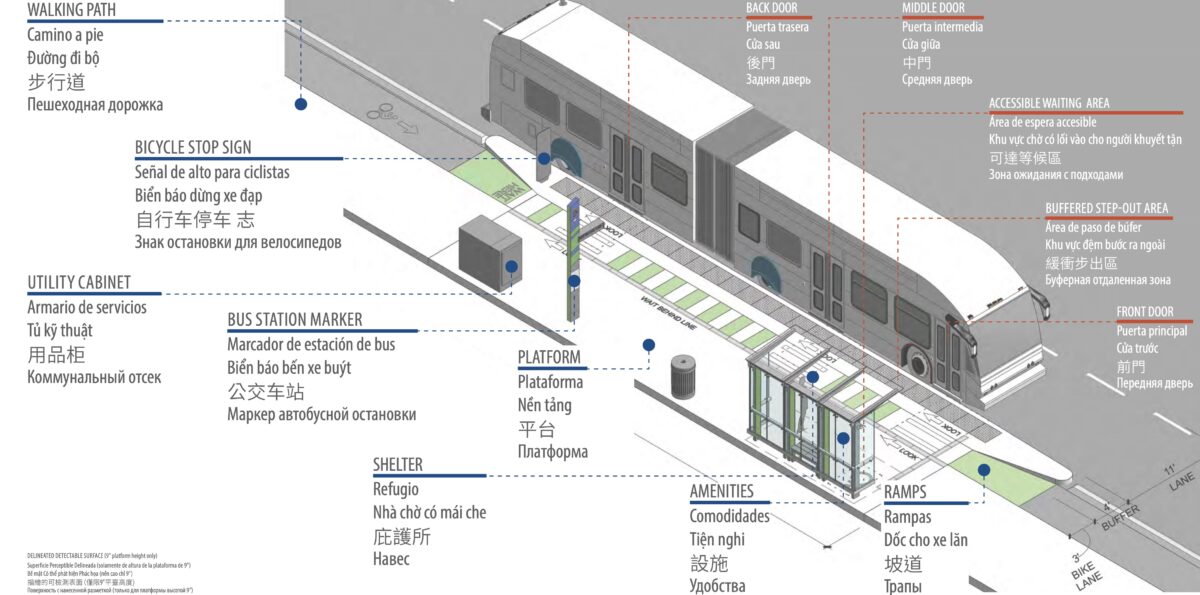
(Click for larger version)
TriMet is almost at the end of the design phase for the Division Transit Project, and once again they seek our input via an online open house launched this morning.
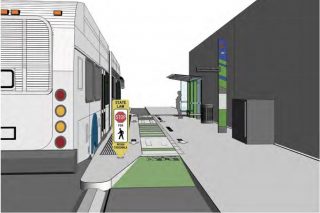
This project is a $175 million investment that aims to significantly improve transit service. But this is a much more than just a transit project.
Statistically speaking, Southeast Division is one of the most dangerous and deadly streets in Portland. Five intersections on Division are ranked in the top 20 overall according to the transportation bureau’s high crash network analysis. Four of those five intersections will see major changes as part of TriMet’s project and/or PBOT’s related Outer Division Safety Project.
I’ll share the latest on PBOT’s work in a separate post. For now, let’s look at TriMet’s Shared Bicycle and Pedestrian station design (as shown above).
TriMet plans to build 72 new bus stations on Division in the 12 miles between SE 10th Avenue and the Cleveland Park & Ride in Gresham. 30 of those merit our close attention because they’re a new design that will put cycling traffic between a stopped bus and its passengers. TriMet has been working on this design since 2017 and now is one of our last chances to weigh in before construction starts later this year.
Back in October TriMet did a live demo of this design.
Advertisement
Here are a few samples of how these new stations will be oriented in relation to the street (note the presence of protected cycling lanes (light green) and center medians):
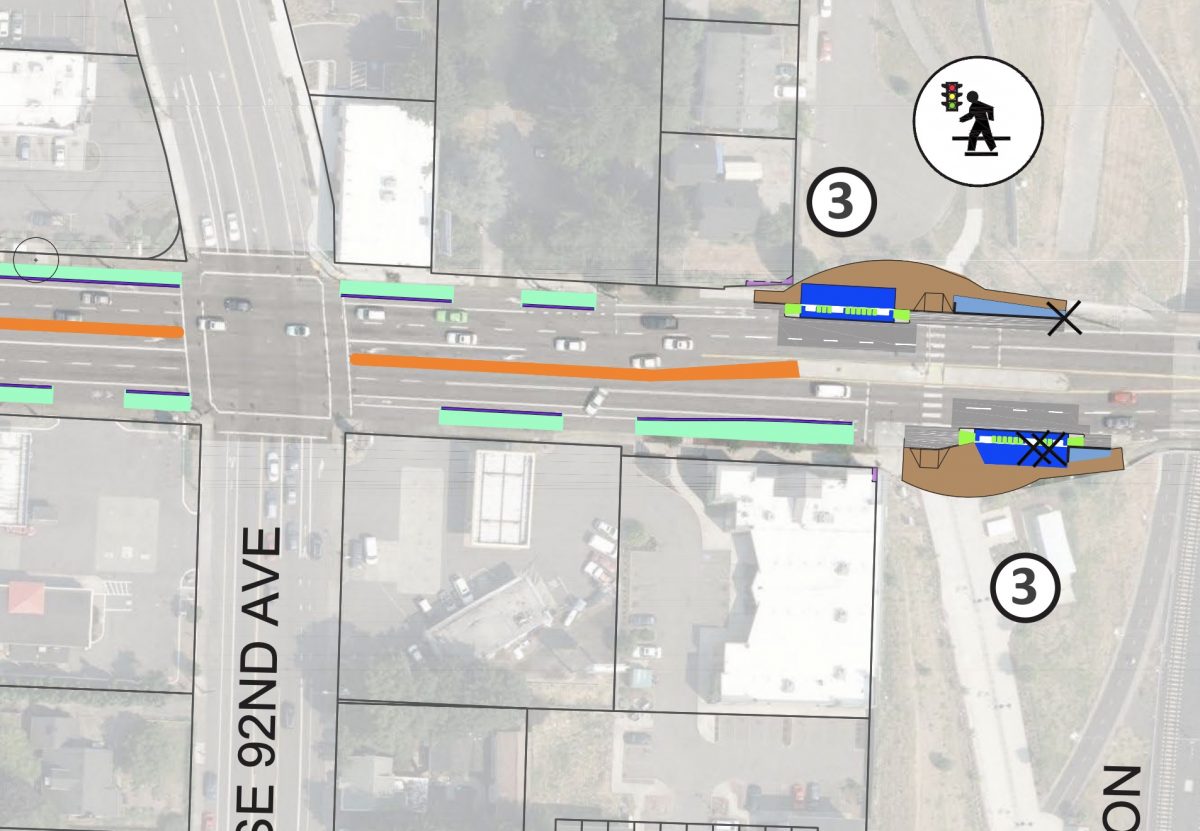
And here’s the design concept again so you don’t have to scroll:

Compare that with the October 2017 design concept to get an idea of how TriMet’s thinking has evolved:

The Shared Bicycle and Pedestrian station design shows the bike lane narrowing to three feet as it enters the station area. There would be a four-foot wide concrete median on riders’ left side where bus passengers would load and unload. TriMet plans to install a “Bicycle Stop Sign” at the entry point. TriMet says their expectation is that bicycle riders should stop only when a bus is present.
Note that these new Shared Bicycle and Pedestrian stations will only be present east of 84th. The current plans show them at: SE 85th (westbound), SE 87th (eastbound), I-205/Division Max Station (both sides), 101st (both sides), 111th (westbound), 113th (eastbound), 116th (both sides), 122nd (both sides), 130th (both sides), 135th (westbound), 136th (eastbound), 142nd (both sides), 148th (both sides), 157th (both sides), 162nd (both sides), 168th (both sides), 174th (both sides), 182nd (both sides).
These new stations, the 60-foot long articulated buses that will service them, the faster transit operations in general, along with a significant amount of protected bike lanes, new crossings, and center medians (all planned by PBOT in a separate project), could have a major impact on Division.
Service of the new line is expected to open in 2022. Please check out TriMet’s online open house to help them improve this project.
— Jonathan Maus: (503) 706-8804, @jonathan_maus on Twitter and jonathan@bikeportland.org
Never miss a story. Sign-up for the daily BP Headlines email.
BikePortland needs your support.


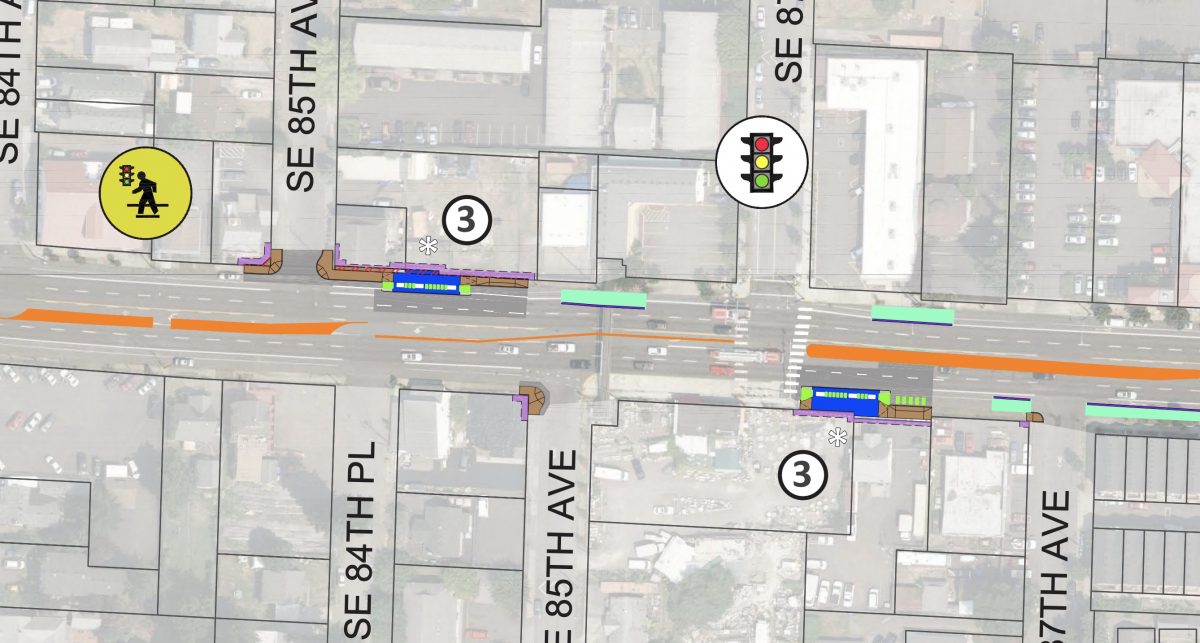
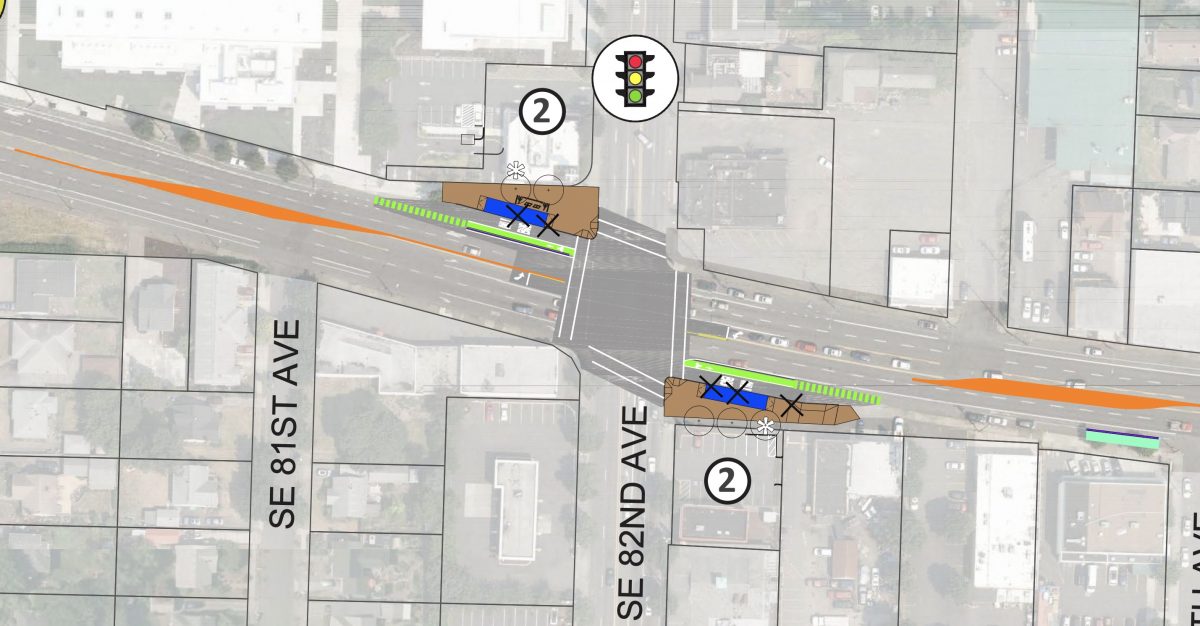
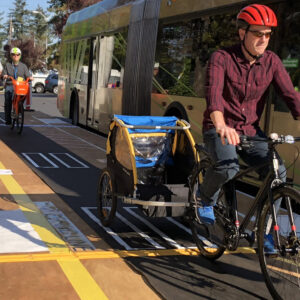
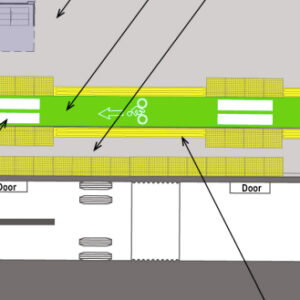
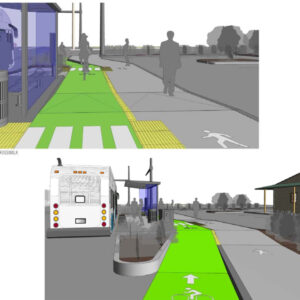
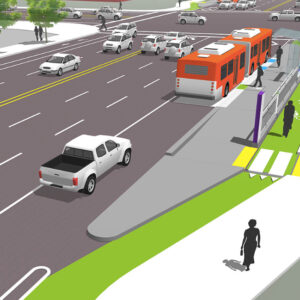
Thanks for reading.
BikePortland has served this community with independent community journalism since 2005. We rely on subscriptions from readers like you to survive. Your financial support is vital in keeping this valuable resource alive and well.
Please subscribe today to strengthen and expand our work.
Jonathan, did TriMet discuss crossing improvements for people catching the bus? Will the medians shown allow riders to cross at places other than crosswalks?
4-lane crossings, even with a median island, require a rapid flash beacon under current Portland design standards. Islands can be modified. Rapid flash beacons run about $45k per cross walk.
that would be nice at Going/MLK, but as nice as bike lanes on Skidmore and being able to use the full trafffic signal!
How about Shaver instead?
This is a bad design that sets up conflicts between transit riders and people on bikes. The only reason it exists is because of the insistence on maintaining 6 vehicular lanes at the intersections.
I think PBOT is aware of how poor and atypical a design this is. They had a fairly good one at the outset. Unfortunately, it is a political decision.
The more I look at the new design, the more committed I will be to pass the bus in the traffic lane on the bike. It is too dangerous going past the bus doors with peds when the bus stops.
all those extra turn lanes to store stopped cars are the result of using signals to control the intersection.
For once I completely agree with you. Division from 80th to 202nd (in Gresham) was designed to be a 6-lane arterial with a center-turn median, with signals every half mile, the worst possible design for an urban street – fast car throughput and little or no pedestrian or bike safety, especially as so many sidewalks were never built until recently. I currently live in a city with many Division streets, which East Portland also has several, and they are all uniformly horrible.
I’m troubled by the debate shown so far on this project. Division right now is horrifying to bike on, with a too-narrow painted bike lane that is totally inappropriate for the traffic speeds and volume. But the parallel routes from 60th to 176th (where Portland ends and Gresham begins) are a half-mile off, on either Market/Mill/Millmain/Main to the north, or the even more horrifying Powell Blvd to the south. So what TriMet is proposing, as imperfect as it might be, is a vast improvement over what PBOT has done over the 30 years since annexation, which is absolutely nothing. I’m amazed by both how progressive what Trimet is proposing, but also by the fact that a transit agency anywhere is proactively proposing anything progressive at all.
But what really gets to me is Portland’s mania for making everything uniform, the same everywhere, lanes, signals, sidewalks, street names, street width, the types of bike lanes, signage, etc. If Portland was a small town, it might be understandable, as the city is trying to create a common identity. But Portland isn’t a small city, it’s quite large, really, growing faster than most other major cities. So I feel it needs to create more unique districts with unique local identities, and Division is the perfect street to create several distinct cultural districts, destinations in their own right, rather than communities to pass through at 45 mph.
Take the Jade District and Division-Midway as two examples. Both want to be local “main street” local business districts. To create a main-street experience, traffic needs to be both congested and moving at a crawl. So why not make Division between 80th and say 94th one-lane only, with a center turn lane, and do the same from 115th to 130th for Midway? And why not change the name of the street to “Jade” and “Midway” for those portions respectively?
For those portions, experiment with changing the signals or eliminating them altogether and adding 4-way stop signs instead? Maybe a roundabout at 82nd & 122nd? Maybe a shared bus/bike lane on the right, for faster cyclists and #8 express buses, as well as the all-too-frequent emergency vehicles?
How about having blue street name signs instead of Portland green? Jade-color bike lanes?
Sorry to go on a rant. I sometimes get carried away.
Yikes! Routing cyclists between the bus shelter and the bus is really a better solution then sending them behind? Seems like a recipe for problems. Will there be a stop sign preventing bus passengers from stepping into the bike lane when there’s no bus there?
“Will there be a stop sign preventing bus passengers from stepping into the bike lane”
There will be two, one for each lane of traffic, bicycles and pedestrians!
They’re bound and determined to ruin every single fast bike commute route in the city.
Some minor design details may need to be reworked on maintenance, consider:
– extending the start of the ramp past the end of the island AND making the edge at a oblique (45 degrees? to the curb and not 90 degrees) so that any gutter debris not carried past the ramp with normal rainfall could possibly be swept away by a street sweeper. (Does anyone from streets maintenance QAQC these designs?) So long as the cargo of kiddie trailers are not endangered.
These platforms look compatible with existing buses. Please please please build just one of these as a pilot now so we can see whether having a bike lane right through the middle of a transit platform works in practice. If it does, we’ll ready to go. If it doesn’t, it will be much easier to adjust.
Would love to see a demonstration of this design on a road like Beaverton-Hillsdale Hwy where it is space constrained and the buses currently use the entire MUP/bike lane for every stop.
For a project like this it’s disappointing to see TriMet’s thinking change because they made the active decision to allocate funding elsewhere.
We already have similar examples for the Streetcar boarding platforms. Lovejoy at NE 13th is an example. But buses will be on much greater frequency so conflicts between bus passengers and cyclists will be more frequent.
Do the streetcar platforms have railings separating the embarkation/disembarkation area from the bike path? This design does not.
Of course, this is a bad idea for all the same reasons that it would be a bad idea to have a lane of motorized traffic between the bus stop and the bus. Disappointing (but not surprising) that this seems to be hard to understand.
Is this some kind of joke? TriMet is hiring comedians to design their infrastructure now?
It’s almost as if they don’t take bicycling as transportation seriously at all.
Reality:
https://usa.streetsblog.org/2014/06/12/the-street-ballet-of-a-bike-lane-behind-a-transit-stop/
http://bikewalkkc.org/blog/2015/02/best-practices-for-bike-lanes-along-major-bus-routes/
https://www.streetfilms.org/how-seville-handles-where-bus-stops-protected-bike-lanes-meet/
https://www.youtube.com/watch?v=2Pvhkx0153k
The reality is that TriMet’s design is dangerous. These videos do not show it working; they show a different, safer design that TriMet should adopt.
I especially like the Seville design with with advertisement on the shelter glass blocking the views which are necessary for safe interaction between bikes, peds, and transit users. The other designs show a wider bike path than the proposed designs for Division. The examples also exhibit the bike ROW behind the transit islands. THIS IS AN EXPERIMENTAL DESIGN CONCEPT proposed for Division and Trimet and PBOT have no idea how it will work. That’s the long and short of it!
Looks like another example of granting engineering degrees to Twitter users for logging hours in multimedia.
The new design will make a mess from cyclists running into peds stepping off the buss with a half second warning to the cyclist. Lots of peds looking for a chance to sue someone by waiting at an open door for a chance to step out into the front wheel of a bike and holler OUCH!! I think I will give division a wide birth if they go that way. Behind the kiosk is no problem. the cyclist would at least have some warning that someone wearing ear buds was going to walk in front of them.
When I look at those design images I hear John McEnroe in my head…
“You cannot be serious!?!”
Reality:
https://usa.streetsblog.org/2014/06/12/the-street-ballet-of-a-bike-lane-behind-a-transit-stop/
http://bikewalkkc.org/blog/2015/02/best-practices-for-bike-lanes-along-major-bus-routes/
https://www.streetfilms.org/how-seville-handles-where-bus-stops-protected-bike-lanes-meet/
https://www.youtube.com/watch?v=2Pvhkx0153k
The designs shown in those videos are different than TriMet’s — they route riders around behind the platform, not through the middle as TriMet is proposing.
Ridiculous. Doesn’t TriMet visualize their ridership’s behavior? With this design, not only will the bike lane be blocked during loading, bu the rest of the time people will stand in it while waiting to get a better view down the street for their arriving bus. The original floating platform solves both issues and is obviously designed for throughput with less friction between users. Someone cheaped out and usability was the first casualty.
Isn’t this design widely used in other countries? From what I have seen in person and online it seems to work fine. I don’t quite understand the the common attitude that things that work in other countries ( like bus stations and health care) won’t work here. Are Americans less cooperative, or more self centered , or more distracted than people in other lands?. Perhaps instead of trying to come up with “American Style Solutions” for everything we should think more about our social stucture, education etc. Or are we at some kind of cultural dead end? Please help me here.
Yes. It is widely used across Europe albeit given the PBL behind the bus shelter. Behind being the key word.
So basically, they’re setting it up to eventually ban bicycles from Division the first time thete’s a collision between a bicycle and a pregnant mom with a stroller. And of course, then there are the salmon-riders to think of. Both these scenarios will likely happen at the same time.
Don’t worry, TriMet can retrofit the bike lanes through the station areas with swing gates like those they installed along the Orange Line.
Is this how they get their kicks? The ped vs bike version of cockfighting?
Just amazing how many planning experts there are not working in the field.
It’s easy to find the Design Guidance in the NACTO manual and the basic flaw in this design.
https://nacto.org/publication/urban-bikeway-design-guide/cycle-tracks/one-way-protected-cycle-tracks/#design
Yes perfect. Why is the NACTO guidance NOT used in this case (PBoT is a board member of NACTO) – I looked it up too? It is based on International Best Practices (and my memory of similar layouts in the NL, DE, etc.). It looks like the initial preliminary designs were better so what the ____ happened? (Is there anyone on the project stakeholder or advisory committee – who reads this blog – can help us understand the “improved” design? (Did Trimet seek input on this change with City’s PBAC?) Or does TRIMET still have “Bikeway-PTSD” from the first local bikeway behind the Streetcar shelter bikeway bypass the City had in the Pearl back in 2002? (Yes, it was not as good as it could have been designed due to the grade/ speeds…but we know how to do it better now!)
My recollection is that it boils down to money (and perhaps lack of political will). The earlier design would have required purchase of adjacent land for a wider right of way (assuming no reduction in the design’s auto lanes.)
Which guidance, exactly?:
https://nacto.org/publication/transit-street-design-guide/stations-stops/stop-configurations/shared-cycle-track-stop/
https://nacto.org/publication/transit-street-design-guide/transit-streets/two-way-streets/neighborhood-transit-street-bike-lane/
https://nacto.org/publication/transit-street-design-guide/stations-stops/stop-configurations/side-boarding-island-stop/
Photos in the second two documents you link to show a much different design than TriMet is proposing.
And the text in document 2 reads, in part, “Boarding islands direct bicyclists behind transit stops, reducing or eliminating most conflicts between transit vehicles and bicyclists, and expanding available sidewalk space. Eliminating the interaction between buses and bicycles at the curb has potentially large safety benefits for bicyclists, while refuge areas on boarding islands improve pedestrian safety and access by reducing exposure and crossing time.”
Or you could say it’s just amazing how many people designing mass transit and bicycle infrastructure obviously use neither mode of transportation 😉
I think it will work fine. There will be a few weeks of adjustment, ringing bells at peds standing in the bike lane while waiting, then everyone will get used to it and it will work. We can deal with waiting for the 20 seconds that a bus is loading, it’s going to be ok.
But there’s a decent chance of getting stuck behind the bus and waiting that 20 seconds at every stop. Of course, if you were in a hurry, why go down Division in the first place — there is that.
Because there’s no good alternative route? We’re talking East portland here, not the inner part of the town where there’s lots of parallel streets.
The alternate route is Lincoln…but you’re right that only applies up to SE 60th, I suppose.
The stop sign blocks the view between those exiting the bus and the cyclist. Normal stop signes are elevated so the sign does not obstruct view.
Looks like I’ll be taking an auto lane, then.
Note that Trimet’s open house is not asking for our feedback on the station design – the only input requested is on the design of the glass in the shelters. Apparently Trimet sees the station design as a done deal.
So THIS is how you get collisions with pedestrians
The only time I have ever been in a bike/ped collision was when I was biking between a bus and the curb in Guatemala. A young woman stepped out of the back door just as the bus started moving. My bike almost knocked her over, and I felt terrible. Although road space in Guatemala is much less segregated (organized) than it is here, a similar situation will be inevitable with this design. All it will take is a little bit of impatience or confusion on the part of a person walking or biking.
Could we get TriMet to come on the show and explain the logic?
This design appears not too dissimilar to the Streetcar stops on Lovejoy and NE 13th. It will be lots worse because of higher transit ridership volumes and greater frequency of transit service.
A sidewalk located behind the boarding area is similar to that used for the Streetcar. Check Lovejoy at NE 13th.
The difference is TriMet wants to put the bike lane through (not behind) the stop.
(For reference: 13th & Lovejoy: https://www.google.com/maps/place/NW+13th+Ave+%26+NW+Lovejoy+St,+Portland,+OR+97209/@45.5300057,-122.684434,3a,43.3y,261.15h,81.37t/data=!3m6!1e1!3m4!1sQCM26GRxuqX8q4rRe4Be_g!2e0!7i13312!8i6656!4m5!3m4!1s0x549509fe84cd0445:0x3c8f74cf59659238!8m2!3d45.5300499!4d-122.6843991)
So let’s give them feedback on what to etch on the glass at the stations. Only instead of suggesting some drawing about the neighborhood, as they want us to, let’s suggest something about how bad the station design is for bicyclists and pedestrians. And make no mistake, if they can get away with this poor design here, they will try to replicate it elsewhere. So even if you don’t ride on Division, you should still care.
With that in mind, here’s what I put down on their open house page. Feel free to copy, or copy and edit, for your submission:
Q: What do you love about SE Division Street and its surrounding neighborhoods?
A: “No opinion.
Reason I’m comment is if Tri-Met is able to install this poorly designed station here, then they’ll also try to put it in other areas of the region where I bicycle more often.”
Q: Which specific location would you like to talk about?*
A: (I clicked SE 82nd and Division since I’m not sure where the proposed bad design is intended)
Q: What would you like visitors to know about the communities and neighborhoods for your location?
A: “I would like visitors to know that people who live in Portland are not as stupid as this station design would suggest.
Why would visitors think that? Because this station design is inconvenient and stupid for bicyclists and transit users, because the station designer put the bike lane between the bus shelter and the bus. Transit users stepping off the bus will be unable to see if a bicyclist is coming down the bike lane. Bicyclists won’t be able to figure out if someone is stepping off the bus that stopped at the station. Transit users waiting for the bus will stand in the bike lane looking down the street trying to figure out if the bus is coming. So bicyclists will have to slow or stop for each of these stations, especially if a bus is present, to avoid running into transit users. Transit users will be at greater risk of being hit by bicyclists than if the bike lane were put behind the shelter. This station design represents lawsuits waiting to happen.
I would like visitors to know that Tri-met chose this station design because they are cheap and don’t want to pay for additional right of way to put the bike lane behind the bus shelter as shown on the original 2017 designs, and/or don’t care about bicycle transportation, and/or they just are incompetent when it comes to designing facilities.
The etching in the glass should have a message which explains this.
Also, since the station design represents lawsuits waiting to happen to save people the trouble of googling for the number, the etching on the glass should include Tri-Met’s legal contact.”
Q: Is there something unique (past or present) about this location that should be celebrated?
A: “No opinion”
Q: Is it okay to contact you if we have more questions?*
A: (I clicked yes and included my contact information)
Bikes (30 lbs) and buses (40,000 lbs?) don’t mix.
This design follows the first rule of bad transportation engineering:
“Design the infrastructure so that users will blame each other for injuries rather than the infrastructure.”
This project is particularly good because people are already blaming future bike riders for collisions that they know are inevitable with this design.
Criticism without solutions is less than helpful. The reality is that this form of transit-bike interaction is used where cyclists are much more frequent than Portland.
https://www.youtube.com/watch?v=2Pvhkx0153k
And it’s already in use in the US:
https://peopleforbikes.org/blog/in-sf-a-bike-lane-between-transit-stop-and-sidewalk-is-working-beautifully-video/
In your video, there is a great solution at 2:17. Run the bike path behind the shelter, rather than through the middle of the station. Given how narrow the landing pad is for people getting off the bus, many will likely step directly onto the bike path before they get their bearings.
And your other video also shows much the same thing.
The solutions have already been thoroughly discussed here and elsewhere. My comment is in support of those solutions. The bike lane goes behind the bus stop like at the SW Moody streetcar stops. This design is being promoted for short-sighted budgetary reasons and car worship, not because it is the better design.
And yes, I am not surprised that conflict inducing designs work better in places where many more people, whether they are getting on a bus or riding a bike, have experience riding a bicycle.
Wow! Did you post videos of well designed bike lanes behind transit loading rather than in between the bus and the transit loading just to see if I would watch the links?
The 2017 design was better. The main reason being the location of the bus shelter and the width of the bus rider waiting area.
The first bus stop bypass in Vancouver, BC was this one similar to the latest design for Division :
https://flic.kr/p/8PE7AZ
It works okay as people became used to it and there’s only one bus route that stops there however the main gripe people have about it is the location of the bus shelter. You cross the bike lane to get to the bus and behind the bus shelter it’s cramped between it and a wall.
The sightlines are very good. People can see someone coming for a long way so it works. The island is wide.
The zebra crossing markings are ignored. People just cross wherever and it’s fine.
For Division it would probably be okay but people should still pressure them for a better design. (There’s a chance that there isn’t room though.)
The waiting island could be longer so when there’s a long line of people waiting to board they have somewhere to do it.
The stop sign should be a yield to pedestrians sign. If TriMet’s expectation is that when people are cycling they only stop when there’s a bus present then the sign should say that. Not a stop sign and then, wink, wink, it’s okay the rest of the time. We all know some busy-body is going to wait there and count how many people are not stopping at other times and use it against cyclists. We’ve had this happen in Vancouver and the only solution is to state what you mean. Have a yield sign so that doing what makes sense is also the lawful thing.
Why not build a single stop of the old and new designs, then take public input before building the rest?
Or at very least one of the new ones since we’re going to have to build them anyway.
Or do them as temporary demonstration projects.
TriMet is a toxic organization. They are putting both cyclists and their customers in harms way with this insane design. TriMet, as an organization, will not be happy until the roads are only populated by their buses and trains.
I can’t believe I’m proposing this, but IF this is the chosen design then we need automated gates. Automated gates that keep people in the bus waiting area when there is no bus that then swing open and block the bike path (like a train gate) when the bus is there. Yes it will add seconds (a minute?) onto the stop time for cyclists when a bus arrives/departs but it may actually keep people out of the bike lane and it actually will be a stop for cyclists when walkers are there.
I just think of how many times I’ve had people walking step out right in front of me as I’m riding in a car-parking protected bike lane in both Portland and Seattle (and also along Moody at the bus stop). Because it is protected from car traffic so it feels ok.